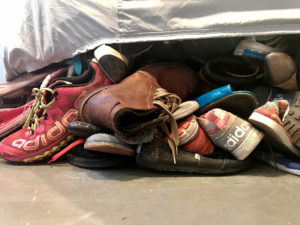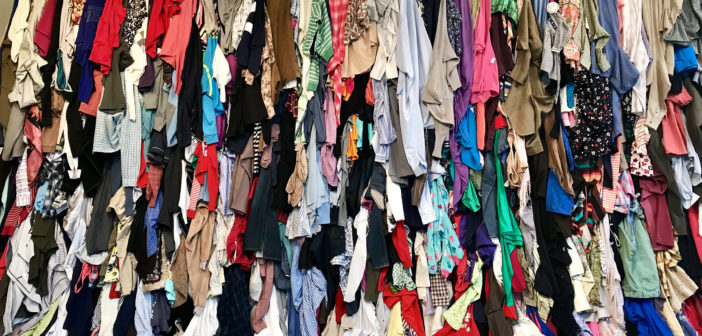As she walked the streets of Dakar, Senegal, in 2010, Karyn Olivier spotted a man standing over a display of used shoes on the top of a covered car, selling his items to passersby.
She stopped, snapped a picture and continued on.
That same picture hung in her Germantown, Philadelphia, studio until she was inspired to turn it into an art piece.
Now, seven years after Olivier took that photograph, a sculpture composed of colorful used shoes and a car cover sits in the main gallery of Zoellner Arts Center.
As this semester’s Horger Artist-in-Residence, Olivier was given the opportunity to create a temporary exhibition at Lehigh, and she worked 12-hour shifts for 13 days to build two individual pieces. For inspiration, she drew from current issues as well as her own experiences.
Olivier said she loved the traffic in Dakar. Drivers honk often as a friendly greeting, rather than out of rudeness. However, driving is a privilege, so there is a lot of walking in African cities like Dakar.
She thought about the shoes, which are people’s biggest need when walking. This led her to wonder about the used items that cycle through American thrift stores and, when unwanted, are sent to Africa and sold on the streets.

Karyn Olivier built a sculpture using old shoes surrounded by a car cover. Olivier was inspired by photograph she took during a 2010 trip to Dakar, Senegal. (Danielle Bettermann/B&W Staff)
“Some of the shoes (for sale) were almost brand new, so it was kind of crazy that (Americans) didn’t want them and they were in export,” Olivier said. “But there were other shoes that were in such horrible condition that you think, ‘Just because someone is poor, why would they want a shoe that has half of the sole gone?’”
From a simple photograph grew a complex outlook on America’s charitable relationship with developing countries, which she eventually channeled into a meaningful sculpture.
Olivier grew up in the Caribbean island of Trinidad and Tobago, studied psychology at Dartmouth College and worked for retail companies in New York, such as Bloomingdale’s and Urban Outfitters.
When she realized she wasn’t using her full creative potential, she focused on taking ceramics classes — at one point selling flavored olive oils and vinegar at New York street fairs for extra funding.
Eventually, she moved to Philadelphia to begin graduate school at the Cranbrook Academy of Arts, and now works as the head of the sculpture program at the Tyler School of Art. Olivier said her lack of artistic background led her to find inspiration in the everyday.
“She wants people to reflect on everyday objects and how you can perceive them differently,” said Pat McAndrew, the head of visitor services and museum education for Lehigh University Arts Galleries. “She’s a very organic artist… she has a general outline, but if something strikes her while she’s working, she will say, ‘Oh, this is really interesting, I can go here with this.’”
Olivier is Lehigh’s third Horger Artist-in-Residence, a program that rotates between music, theater, and art, architecture and design to bring noteworthy artists to campus. The art, architecture and design department worked with the Lehigh University Art Galleries to find the right fit for its first artist-in-residence.
“Her work is so interdisciplinary,” said Wesley Heiss, an associate professor of product design. “It’s something that could appeal to architecture students, and art students, and design students, and beyond the arts — the humanities at large.”
Weiss said one of Olivier’s strengths is her ability to connect with the community and people through her work. Although she makes some of her work political, she doesn’t tell the observer what to think.
Olivier’s second exhibition piece in the Zoellner gallery is a brick wall with hundreds of clothing items woven through it. She said people often view walls as concrete and absolute, so she wanted to create a wall that was massive yet not completely solid.
“I always think about that picture of when the Berlin Wall was coming down… and about how that wall kept families apart and it felt so impenetrable — it felt like there was no way to break that,” she said. “And then in that one instance, that wall became completely dissolved.”
The clothing Olivier wove through the bricks shows just a little in the front, which an observer will notice first. The clothing then falls down the backside of the bricks and creates a complete wall of color.
To Olivier, the clothing woven through the wall could be a metaphor for the body, and the compression of the items reminds her of refugees. However, she finds aesthetic beauty in the piece.
“The clothing has all of the idiosyncrasies of individuals,” said Mark Wonsidler, the curatorial associate for exhibition, collections and publications. “Clothing that identifies different ages, different socioeconomic classes.”
In addition to her gallery exhibitions, Olivier will create a permanent piece for Lehigh’s campus, which she hopes will resonate with the Lehigh and Bethlehem communities’ past, present and future. She is also teaching a class called Monuments, Playgrounds and the Town Square, which addresses artistic and social topics that interest her.
Olivier said she reminds her students often of the importance of curiosity in art, because being an artist requires the desire to connect with other people and see oneself reflected in them.
“I think that artists need to be rubbing up and wrestling with things,” she said. “I would never want to become complacent. The goal is to keep believing in it, because there’s enough reasons to not.”






Comment policy
Comments posted to The Brown and White website are reviewed by a moderator before being approved. Incendiary speech or harassing language, including comments targeted at individuals, may be deemed unacceptable and not published. Spam and other soliciting will also be declined.
The Brown and White also reserves the right to not publish entirely anonymous comments.